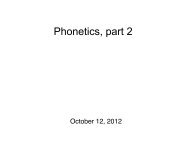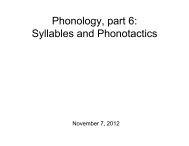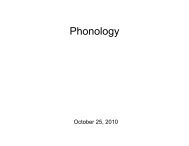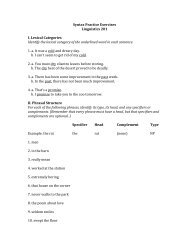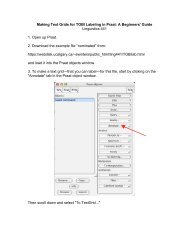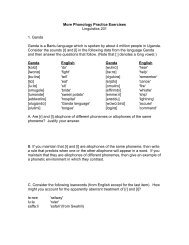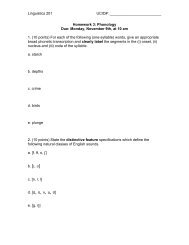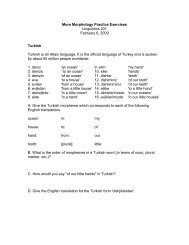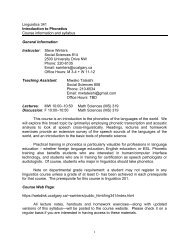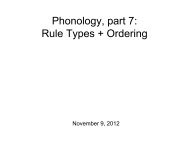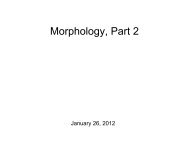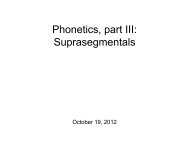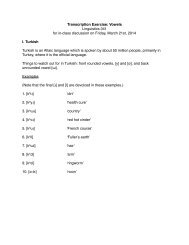Phonology Practice Exercises, part 3 Linguistics 201 1. Syllable ...
Phonology Practice Exercises, part 3 Linguistics 201 1. Syllable ...
Phonology Practice Exercises, part 3 Linguistics 201 1. Syllable ...
You also want an ePaper? Increase the reach of your titles
YUMPU automatically turns print PDFs into web optimized ePapers that Google loves.
<strong>Phonology</strong> <strong>Practice</strong> <strong>Exercises</strong>, <strong>part</strong> 3 <br />
<strong>Linguistics</strong> <strong>201</strong> <br />
<strong>1.</strong> <strong>Syllable</strong> Structure <br />
For each of the following words, (i) give an appropriate broad phonetic <br />
transcription and then (ii) show how the word is syllabified by clearly labeling the <br />
segments in the onset, nucleus and coda of each syllable. <br />
a. Election <br />
b. Frisbee <br />
c. Advertise <br />
d. Demonstrate <br />
e. Confusing
2. Quebec French <br />
In the Quebec French data below, consider the distribution of [t] and [t s ] (a voiceless <br />
alveolar affricate). State their distribution and determine if they are allophones of <br />
one phoneme or of separate phonemes. If you think they contrast, provide evidence <br />
that they do. Otherwise, state the environment in which each allophone appears. <br />
Note that Quebec French includes two vowels which are not found in English: <br />
[y] <br />
[ʏ] <br />
a high, front, tense, rounded vowel <br />
a high, front, lax, rounded vowel <br />
(Also-‐-‐the French /r/ is phonetically different from English /r/, but that fact is <br />
irrelevant to the solution of this problem.) <br />
[tu] 'all' [telegram] 'telegram'<br />
[abut s i] 'ended' [trɛ] 'very'<br />
[tɛl] 'such' [kʏlt s yr] 'culture'<br />
[tab] 'stamp' [minʏt] 'minute'<br />
[t s imɪd] 'timid' [t s y] 'you'<br />
[t s ɪt] 'title' [t s ʏb] 'tube'<br />
3. Korean <br />
Consider the sounds [l] and [r] in the data from Korean below and then answer the <br />
questions that follow. Note that Korean [l] and [r] are phonetically different from <br />
their English counter<strong>part</strong>s, but this fact is irrelevant to the solution of this problem. <br />
[mul] 'water' [mal] 'horse' <br />
[mulkama] 'place for water' [malkama] 'place for horse' <br />
[mure] 'at the water' [mare] 'at the horse' <br />
[pal] 'foot' [pari] 'of the foot' <br />
[səәul] 'Seoul' [rupi] 'ruby' <br />
[ilkop] 'seven' [ratio] 'radio' <br />
Are [l] and [r] contrastive sounds, or are they allophones of the same phoneme? If <br />
you think they contrast, provide evidence that they do. Otherwise, state the <br />
environment in which each allophone appears.



